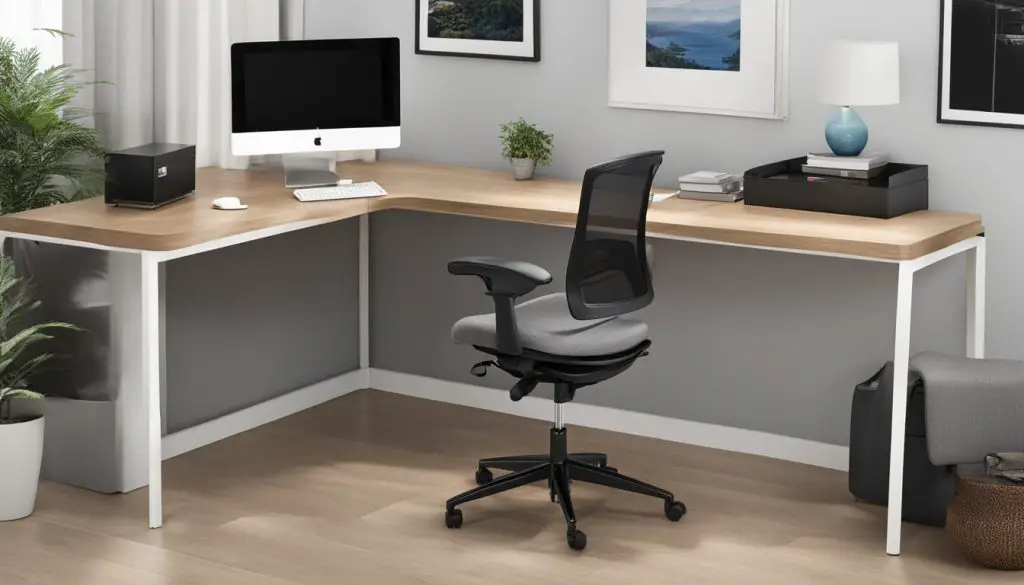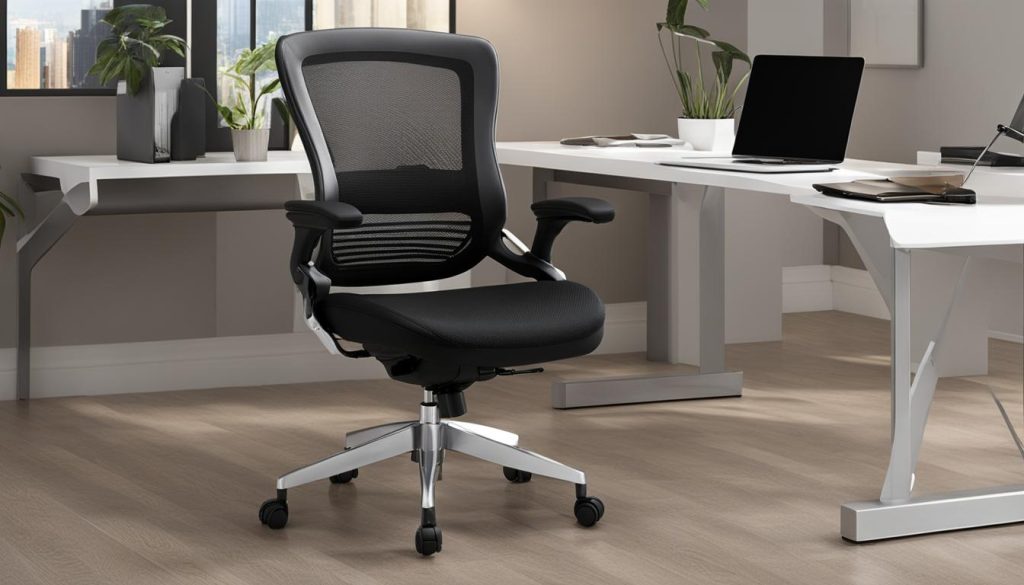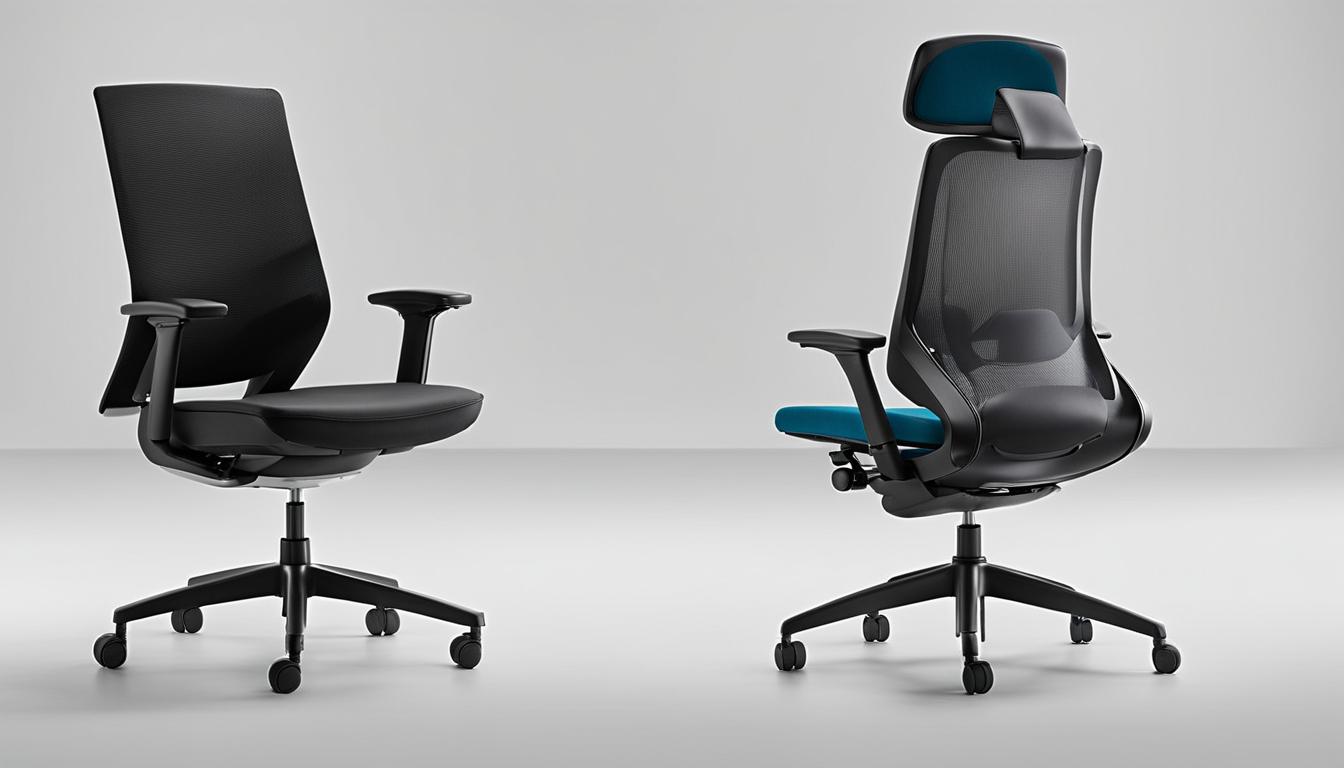In today’s fast-paced work environment, ergonomic chairs play a crucial role in enhancing productivity and well-being during extended work periods. The cost of ergonomic chairs varies depending on the features and benefits they offer. Understanding the differences between a task chair and an office chair can help you make an informed buying decision.
Key Takeaways:
- Task chairs and office chairs have different designs and functionalities.
- Task chairs are generally more compact and designed for short-term use, while office chairs are larger and meant for longer work periods.
- Office chairs often have more adjustable features and ergonomic support, making them suitable for prolonged sitting.
- Consider your specific needs, work duration, and budget when choosing between a task chair and an office chair.
- Both task chairs and office chairs can contribute to improved comfort and productivity when properly selected.
The Comprehensive Guide to Ergonomic Chair Price Ranges
When it comes to ergonomic chairs, the price range can vary significantly based on the features and benefits they offer. Understanding these price ranges can help you make an informed decision when choosing the right chair for your needs. Let’s explore the different price categories and what you can expect within each range.
Budget-Friendly Chairs (Under $100)
In the tight-budget range, you’ll find basic desk chairs that provide minimal adjustability and limited features. These chairs are suitable for short-term use or occasional sitting. While they may not offer the same level of comfort and support as higher-priced options, they can still provide some ergonomic benefits for those on a budget.
Mid-Range Chairs ($100 – $400)
The mid-range price category offers a wide selection of ergonomic chairs with better lumbar support, adjustable features, and improved comfort. Chairs in this range often have additional features like adjustable armrests, tilt mechanisms, and seat height adjustment. They are suitable for individuals who spend several hours working at a desk and prioritize comfort and support.
Premium Chairs ($400 – $1000+)
For those looking for the highest level of comfort and advanced features, the premium range is the way to go. Chairs in this category offer superior lumbar support, customizable seat depth, and even musculoskeletal support. They are designed with the needs of individuals who spend long hours at a desk in mind, providing optimal support and promoting good posture.
| Price Range | Features | Benefits |
|---|---|---|
| Budget-Friendly (Under $100) | Minimal adjustability, basic features | Cost-effective option, suitable for occasional use |
| Mid-Range ($100 – $400) | Better lumbar support, adjustable features | Improved comfort, suitable for extended use |
| Premium ($400 – $1000+) | Advanced features, musculoskeletal support | Superior comfort, optimal support for long hours |
Factors Affecting the Price of Ergonomic Chairs: A Comprehensive Guide
When it comes to choosing the right ergonomic chair for your workspace, understanding the factors that can influence its price is key. Several elements contribute to the overall cost of an ergonomic chair, and being aware of these factors can help you make an informed decision. Here are some key factors that affect the price of ergonomic chairs:
- Design and aesthetics: Ergonomic chairs come in a variety of designs and styles. Chairs with sleek and modern aesthetics tend to be priced higher compared to simpler designs.
- Material quality and durability: The materials used in the construction of the chair, such as high-quality upholstery and durable frame materials, can impact its price. Chairs made with premium materials tend to have a higher price tag.
- Ergonomic features and adjustability: The level of ergonomic features and adjustability offered by the chair can significantly affect its price. Chairs with advanced features like adjustable lumbar support, seat depth adjustment, and armrests tend to be priced higher.
- Additional accessories and options: Some ergonomic chairs offer additional accessories or options, such as headrests, footrests, or different types of armrests. These added features can increase the overall price of the chair.
- Brand reputation: Established brands with a reputation for producing high-quality ergonomic chairs often come with a higher price tag. However, investing in a reputable brand can provide assurance of durability and performance.
When considering an ergonomic chair for your workspace, it’s important to prioritize the factors that align with your specific needs and budget. Assessing the design, materials, ergonomic features, and additional options can help you find the right balance between price and functionality.
| Factor | Impact on Price |
|---|---|
| Design and aesthetics | Higher-priced chairs often have sleek and modern designs. |
| Material quality and durability | Premium materials contribute to the higher cost of chairs. |
| Ergonomic features and adjustability | Chairs with advanced features tend to be priced higher. |
| Additional accessories and options | Added features can increase the overall price of the chair. |
| Brand reputation | Established brands often come with a higher price tag. |
Choosing an ergonomic chair involves finding the right balance between price and functionality. It’s important to prioritize your specific needs and consider factors such as design, materials, ergonomic features, and brand reputation. By understanding the factors that influence the price of ergonomic chairs, you can make a well-informed decision that supports your comfort and productivity in the long run.
Unveiling the True Value: Cost vs. Benefits of Ergonomic Chairs
In today’s modern work environment, where long hours of sitting have become the norm, investing in an ergonomic chair is crucial for maintaining productivity and ensuring the well-being of employees. While the initial cost of an ergonomic chair may seem higher compared to a traditional office chair, it is important to understand the true value and long-term benefits it offers.
One of the key benefits of ergonomic chairs is their ability to improve posture and prevent musculoskeletal disorders. These chairs are designed to provide proper lumbar support, adjustable seat height, and other ergonomic features that promote a neutral spine position. By maintaining good posture, employees can minimize the risk of developing back pain, neck strain, and other related issues.
Furthermore, ergonomic chairs can have a positive impact on productivity. When employees are comfortable and supported in their chairs, they are able to focus better on their tasks without being distracted by discomfort or pain. This leads to improved concentration, efficiency, and overall work performance.
Investing in an ergonomic chair is not just about the initial cost; it’s about the long-term benefits it provides.
Another significant advantage of ergonomic chairs is their potential to reduce work-related injuries and associated medical expenses. By providing proper support and promoting healthy sitting habits, ergonomic chairs can help prevent common workplace injuries such as repetitive strain injuries and carpal tunnel syndrome. This not only contributes to a safer work environment but also leads to cost savings for both employees and employers.
Table: Benefits of Ergonomic Chairs
| Benefit | Description |
|---|---|
| Improved posture | Ergonomic chairs promote proper spine alignment and reduce the risk of posture-related issues. |
| Enhanced productivity | Comfortable and supported employees are able to focus better and be more efficient in their work. |
| Reduced work-related injuries | Ergonomic chairs help prevent common workplace injuries, leading to fewer medical expenses. |
| Cost savings | Preventing injuries and improving employee well-being can result in long-term cost savings. |
When considering the cost vs. benefits of ergonomic chairs, it is important to look beyond the initial price tag. The true value lies in the long-term advantages they offer, including improved posture, increased productivity, reduced injuries, and potential cost savings. By prioritizing the well-being of employees and providing them with ergonomic seating solutions, companies can create a healthier and more productive work environment.
Reasons Why Your Ergonomic Chair May Not Provide Expected Results
Despite investing in an ergonomic task chair, some individuals still experience discomfort and back pain while working. There are several factors that can contribute to this situation:
- Poor Ergonomic Chair Setup: Incorrect chair setup is a common issue that prevents individuals from experiencing the full benefits of their ergonomic chair. Ensuring that the chair is adjusted to the correct height, with proper lumbar support and armrest positioning, is essential for maintaining good posture and reducing strain on the body.
- Poor Posture Habits: Even with an ergonomic chair, poor posture habits can undermine its effectiveness. Slouching or sitting in awkward positions can strain the muscles and joints, leading to discomfort. It’s important to practice proper posture by sitting upright, maintaining a neutral spine, and engaging the core muscles.
- Prolonged Sitting: Sitting for extended periods, even in an ergonomic chair, can still put strain on the body. It’s crucial to take regular breaks, stretch, and move around to prevent muscle stiffness and promote blood circulation.
- Underlying Health Conditions: Some individuals may have pre-existing health conditions that contribute to their discomfort, such as herniated discs or arthritis. In such cases, an ergonomic chair may help alleviate symptoms but may not completely eliminate discomfort.
- Lack of Core Strength: A weak core can affect the body’s ability to maintain proper posture and support the spine. Incorporating core-strengthening exercises into a daily routine can enhance the benefits of an ergonomic chair and reduce discomfort.
Addressing these issues can help maximize the benefits of an ergonomic chair and alleviate discomfort. It’s important to ensure proper chair setup, practice good posture habits, take regular breaks, and consider incorporating exercises to strengthen the core muscles. By being mindful of these factors, individuals can create a more ergonomic and comfortable workspace.
Expert Insight:
“Proper chair setup and posture are key to experiencing the full benefits of an ergonomic chair. It’s important to adjust the chair to the correct height, maintain proper lumbar support, and engage the core muscles for optimal support and comfort.” – Dr. Lisa Thompson, Ergonomic Specialist
Achieving Ergonomics in Your Workspace
Creating an ergonomic workspace is crucial for maintaining good posture, reducing discomfort, and maximizing productivity. By following a few simple tips, you can optimize your workspace to promote a healthier and more comfortable work experience.
- Choose the right chair: Investing in an ergonomic task chair with proper lumbar support is essential. Look for chairs that can be adjusted to your body’s needs, such as seat height, backrest angle, and armrest height.
- Position your monitor and keyboard correctly: Ensure that your monitor is at eye level and positioned directly in front of you. Your keyboard should be at a comfortable height, allowing your arms to rest comfortably on the desk.
- Take regular breaks: Sitting for prolonged periods can be detrimental to your health. Take short breaks every hour to stretch your legs, walk around, and give your body a break from sitting.
- Invest in a standing desk: Consider using a standing desk to alternate between sitting and standing throughout the day. This can help alleviate the strain on your back and improve circulation.
- Organize your workspace: Keep frequently used items within reach to minimize unnecessary movements and strain. Use desk organizers and cable management solutions to keep your workspace tidy and free of clutter.
“Creating an ergonomic workspace is more than just having the right chair. It’s about setting up your entire workspace in a way that promotes comfort and supports your body’s needs.”
| Workspace Element | Ergonomic Consideration |
|---|---|
| Chair | Adjustable seat height, lumbar support, and armrests |
| Monitor | Positioned at eye level, directly in front of the user |
| Keyboard | Comfortable height, allowing for relaxed arm positions |
| Desk | Proper height and depth to accommodate the user’s needs |
| Accessories | Cable management solutions, desk organizers |
By following these guidelines and customizing your workspace, you can create an ergonomic environment that promotes both comfort and productivity. Remember to listen to your body’s needs and make adjustments as necessary, ensuring a healthier and more comfortable work experience.
Why Ergonomics Is Important
In today’s fast-paced work environment, prioritizing ergonomics is essential for optimizing comfort, efficiency, and overall well-being. Ergonomics, the study of how people interact with their work environment, plays a crucial role in enhancing physical and mental comfort, preventing musculoskeletal disorders, reducing fatigue, and improving overall productivity.
By creating an ergonomic workspace and investing in an ergonomic task chair, you can optimize your posture, reduce discomfort, and minimize the risk of work-related injuries. Ergonomic chairs are designed to provide proper support to the spine, promote good posture, and offer adjustability features that cater to individual needs.
Moreover, embracing ergonomics in the workspace has numerous benefits beyond physical comfort. It contributes to better concentration and focus by reducing distractions caused by discomfort or pain. This, in turn, improves productivity and work performance. Prioritizing ergonomics also leads to employee satisfaction and retention, as employees feel valued and supported in their well-being. Additionally, incorporating ergonomic practices can have long-term health benefits, such as reducing the risk of chronic pain and musculoskeletal disorders.
Creating an ergonomic workspace not only enhances your overall well-being but also serves as an investment in your comfort, efficiency, and longevity. By prioritizing ergonomics, you can create a workspace that supports your body’s needs and promotes a healthier and more comfortable work experience.
Focusing on Ergonomic Benefits
Here are some key benefits of prioritizing ergonomics in your workspace:
- Enhanced well-being and reduced risk of musculoskeletal disorders
- Improved physical and mental comfort
- Increased productivity and work performance
- Prevention of work-related injuries and associated medical expenses
- Employee satisfaction and retention
- Long-term health benefits, such as reduced chronic pain
By understanding the importance of ergonomics and its benefits, you can make informed decisions when setting up your workspace and selecting an ergonomic task chair. Prioritizing ergonomics will not only improve your overall well-being but also enhance your efficiency and comfort during work hours.

| Ergonomic Task Chair | Regular Office Chair | |
|---|---|---|
| Back Support | Provides proper lumbar support and promotes good posture. | May lack adequate support, leading to poor posture and discomfort. |
| Adjustability | Offers multiple adjustable features, such as seat height, armrests, and lumbar support. | May have limited adjustability options, compromising individual comfort. |
| Comfort | Designed for optimal comfort, with cushioning and ergonomic contours. | May lack ergonomic design, resulting in discomfort during long periods of sitting. |
| Health Benefits | Reduces the risk of musculoskeletal disorders and related health issues. | Provides minimal health benefits and may contribute to posture-related problems. |
| Productivity | Enhances productivity and concentration through ergonomic support and comfort. | May result in distractions and reduced productivity due to discomfort. |
The Benefits of Ergonomics
Embracing ergonomic practices in the workplace offers numerous benefits. When you prioritize ergonomics, you create a workspace that promotes comfort, efficiency, and overall well-being. Here are some key benefits of incorporating ergonomics into your workspace:
1. Improved Productivity
By investing in an ergonomic task chair and creating an ergonomic workplace, you can significantly enhance productivity. When your body is properly supported and comfortable, you can focus better on your work without distractions from discomfort or pain. This leads to increased efficiency and better performance.
2. Prevention of Work-Related Injuries
An ergonomic workplace is designed to minimize the risk of work-related injuries. Ergonomic task chairs provide proper lumbar support, encourage correct posture, and reduce strain on the body. By using an ergonomic chair, you can prevent common musculoskeletal disorders and alleviate the physical stress caused by prolonged sitting.
3. Long-Term Health Benefits
Investing in an ergonomic workplace is an investment in your long-term health. By maintaining proper posture, you can reduce the risk of chronic conditions like back pain, neck pain, and repetitive strain injuries. The ergonomic design of task chairs promotes optimal spinal alignment and supports natural body movements, reducing the risk of developing musculoskeletal issues over time.

| Ergonomic Workplace | Non-Ergonomic Workplace | |
|---|---|---|
| Productivity | Improved | Decreased |
| Health Benefits | Enhanced | Risk of chronic conditions |
| Work-Related Injuries | Prevented | Increased risk |
Creating an ergonomic workspace and investing in an ergonomic task chair contribute to your overall well-being and productivity. By understanding the benefits of ergonomics, you can make informed decisions to optimize comfort and longevity in your work environment.
Conclusion
In conclusion, creating an ergonomic workspace and investing in an ergonomic task chair are crucial steps in optimizing comfort, productivity, and overall well-being. By understanding the differences between task chairs and office chairs, considering price factors and benefits, and addressing common issues, you can make an informed decision that supports your body’s needs.
Remember to prioritize ergonomics in your workspace by taking regular breaks, positioning your monitor and keyboard correctly, and choosing a chair with lumbar support. These small adjustments can make a significant difference in reducing discomfort and improving your work experience.
By embracing ergonomic practices, you can enjoy the numerous benefits they offer. Not only do they improve productivity by reducing distractions, but they also prevent work-related injuries and promote long-term health benefits. Prioritizing ergonomics in your workspace is an investment in your comfort, efficiency, and overall well-being.
So, take the time to create an ergonomic workspace that supports your body’s needs. Listen to your body, make adjustments when necessary, and enjoy the benefits of a healthier and more comfortable work environment.
FAQ
What is the difference between a task chair and an office chair?
Task chairs are designed for shorter periods of sitting and focus on basic comfort and mobility. Office chairs, on the other hand, are designed for longer periods of sitting and offer more advanced features like better lumbar support and adjustability.
How much do ergonomic chairs cost?
Ergonomic chairs come in different price ranges. In the tight-budget range (under $100), you can expect basic desk chairs. In the mid-range ($100 – $400), you’ll find chairs with better lumbar support and adjustable features. The premium range ($400 – $1000+) offers chairs with advanced features like seat depth adjustability and musculoskeletal support.
What factors influence the price of an ergonomic chair?
The price of an ergonomic chair is influenced by factors such as design and aesthetics, material quality and durability, ergonomic features and adjustability, additional accessories and options, and brand reputation.
Do ergonomic chairs provide long-term benefits?
Yes, investing in an ergonomic chair provides long-term benefits. Ergonomic chairs help improve posture, prevent health issues related to prolonged sitting, enhance productivity, and can lead to cost savings by reducing work-related injuries and medical expenses.
Why might an ergonomic chair still cause discomfort or back pain?
Discomfort or back pain while using an ergonomic chair could be due to incorrect chair setup, poor posture habits, prolonged sitting, underlying health conditions, or lack of core strength. Addressing these issues can help maximize the benefits of an ergonomic chair and alleviate discomfort.
How can I create an ergonomic workspace?
Tips for creating an ergonomic workspace include taking regular breaks, investing in a standing desk, choosing a chair with lumbar support, positioning your monitor and keyboard correctly, and organizing your workspace for easy access to frequently used items.
Why is ergonomics important in the workplace?
Ergonomics plays a crucial role in enhancing well-being by preventing musculoskeletal disorders, reducing fatigue, and improving physical and mental comfort. It contributes to productivity, prevents work-related injuries, enhances employee satisfaction and retention, and promotes long-term health benefits.
What are the benefits of ergonomics?
Embracing ergonomic practices in the workspace offers numerous benefits, including improved productivity, prevention of work-related injuries, overall well-being, and long-term health benefits.
How can I choose the right ergonomic chair and set up my workspace?
By understanding the differences between task chairs and office chairs, considering price factors and benefits, addressing common issues, and following ergonomic practices, you can make an informed decision and create a workspace that supports your body’s needs.



